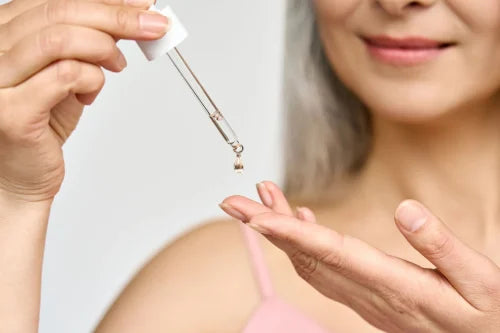
What Is Retinol, How Is It Formed, and How Should It Be Used?
Share
What Is Retinol?
Retinol is one of the most effective skin-renewing active ingredients derived from vitamin A.
It promotes cell turnover and helps reduce the appearance of wrinkles, dark spots, and acne.
It also strengthens the skin barrier, tightens pores, and gives the skin a smoother and more even texture.
Because of these properties, dermatologists often refer to retinol as the gold standard ingredient in anti-aging and acne treatments.
How Is Retinol Formed?
Retinol is a derivative of vitamin A. Once absorbed by the skin, it converts into retinoic acid, the active form that accelerates cell renewal.
This process helps the skin regenerate and look fresher and healthier.
Retinol can be obtained from animal-based vitamin A or synthesized in laboratories.
In modern skincare products, it’s often used in a stabilized form, which makes it safer and more effective for everyday use.

How and When to Use Retinol
Retinol is a powerful active ingredient that can cause sensitivity if not used properly.
Here’s how to use it safely and effectively:
-
Use it at night:
Retinol is sensitive to sunlight, so it should only be applied as part of your night skincare routine. -
Apply to clean skin:
After cleansing, use a pea-sized amount of retinol cream or serum. -
Follow with a moisturizer:
Always apply a hydrating moisturizer afterward to prevent dryness or irritation. -
Wear sunscreen during the day:
Retinol increases sun sensitivity, so make sure to use SPF 30 or higher every morning.
As for frequency:
-
Start with 2–3 times per week,
-
Then gradually increase to nightly use as your skin builds tolerance.
Who Needs Retinol?
Retinol can benefit most skin types, but it’s especially helpful for people who struggle with:
-
Fine lines and wrinkles:
Retinol stimulates collagen production and helps reduce visible signs of aging.
-
Dark spots and acne scars:
It improves skin texture and helps even out the complexion.
-
Oily or enlarged pores:
Retinol minimizes pores and smooths the surface of the skin.
-
Dull and tired skin:
By boosting cell turnover, retinol gives the skin a radiant and refreshed appearance.
Conclusion
When used correctly, retinol can be one of the most powerful ingredients in your skincare routine.
It supports cell renewal, reduces wrinkles, and enhances the overall appearance of the skin.
But to get the best results, consistent use and the right product choice are essential.
References
-
Harvard Health Publishing – Harvard Medical School
“The truth about retinol, retinoids, and vitamin A in skin care”
🔗 https://www.health.harvard.edu/blog/the-truth-about-retinol-retinoids-and-vitamin-a-in-skin-care-202110192616 -
American Academy of Dermatology (AAD)
“Retinoids: What they are and how they work”
🔗 https://www.aad.org/public/everyday-care/skin-care-secrets/anti-aging/retinoids -
Cleveland Clinic
“Retinoids and Retinol: What They Are and How to Use Them”
🔗 https://my.clevelandclinic.org/health/treatments/22893-retinoids-and-retinol
-This article is written for informational purposes only, and the sources of inspiration are listed below !
-
